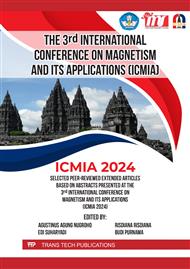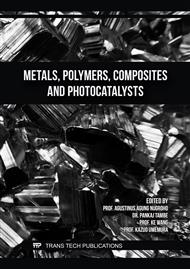[1]
Rybalova, O., Artemiev, S., Sarapina, M., Tsymbal, B., Bakharevа, A., Shestopalov, O., & Filenko, O. (2018). Development of methods for estimating the environmental risk of degradation of the surface water state. Восточно-Европейский журнал передовых технологий, (2 (10)), 4-17.
DOI: 10.15587/1729-4061.2018.127829
Google Scholar
[2]
S. Sahu, S. Pahi, J. K. Sahu, U. K. Sahu and R. K. Patel, Environ. Sci. Pollut. Res. 27 (2020) 22579–22592.
DOI: 10.1007/s11356-020-08561-2
Google Scholar
[3]
S. Kumar Tammina, B. Kumar Mandal, N. Kanth Kadiyala, Photocatalytic degradation of methylene blue dye by nonconventional synthesized SnO2 nanoparticles. 2018.
DOI: 10.1016/j.enmm.2018.07.006
Google Scholar
[4]
Charerntanyarak, L. (1999). Heavy metals removal by chemical coagulation and precipitation. Water Science and Technology, 39(10-11), 135-138.
DOI: 10.2166/wst.1999.0642
Google Scholar
[5]
K. Piaskowski, R. Świderska-Dąbrowska, P.K. Zarzycki, "Dye removal from water andwastewater using various physical, chemical, and biological processes," J. AOAC Int., vol. 101, p.1371–1384, 2018.
DOI: 10.5740/jaoacint.18-0051
Google Scholar
[6]
Oladoye, P. O., Ajiboye, T. O., Omotola, E. O., & Oyewola, O. J. (2022). Methylene bluedye: Toxicity and potential elimination technology from wastewater. Results in Engineering, 16, 100678.
DOI: 10.1016/j.rineng.2022.100678
Google Scholar
[7]
R. Wang et al., Fe3O4/SiO2/C nanocomposite as a high-performance Fenton-like catalyst in aneutral environment, RSC Adv. 6 (2016) 8594–8600
Google Scholar
[8]
Rajabathar, J. R., Thankappan, R., Sutha, A., Al-Lohedan, H., Karami, A. M., Kumar, S. A., ... & Balu, R. (2024). Enhanced photocatalytic activity of magnetite/titanate (Fe3O4/TiO2) nanocomposite for methylene blue dye degradation under direct sunlight. Optical Materials, 148, 114820.
DOI: 10.1016/j.optmat.2023.114820
Google Scholar
[9]
Sudarmono, Istiqomah, N. I., Budianti, S. I., Cuana, R., Puspitarum, D. L., Mahardhika, L. J., & Suharyadi, E. (2024). Magnetically separable and reusable Fe3O4/chitosan.
DOI: 10.1016/j.rechem.2023.101245
Google Scholar
[10]
Liu, S., Yu, B., Wang, S., Shen, Y., & Cong, H. (2020). Preparation, surface functionalization and application of Fe3O4 magnetic nanoparticles. Advances in colloid and Interface Science, 281, 102165.
DOI: 10.1016/j.cis.2020.102165
Google Scholar
[11]
Antarnusa, G., Jayanti, P. D., Denny, Y. R., & Suherman, A. (2022). Utilization of co-precipitation method on synthesis of Fe3O4/PEG with different concentrations of PEG for biosensor applications. Materialia, 25, 101525.
DOI: 10.1016/j.mtla.2022.101525
Google Scholar
[12]
Nakata, K., & Fujishima, A. (2012). TiO2 photocatalysis: Design and applications. Journal of photochemistry and photobiology C: Photochemistry Reviews, 13(3), 169-189.
DOI: 10.1016/j.jphotochemrev.2012.06.001
Google Scholar
[13]
Higashimoto, S. (2019). Titanium-dioxide-based visible-light-sensitive photocatalysis: Mechanistic insight and applications. Catalysts, 9(2), 201.
DOI: 10.3390/catal9020201
Google Scholar
[14]
Xuan, S., Jiang, W., Gong, X., Hu, Y., & Chen, Z. (2009). Magnetically separable Fe3O4/TiO2 hollow spheres: fabrication and photocatalytic activity. The Journal of Physical Chemistry C, 113(2), 553-558.
DOI: 10.1021/jp8073859
Google Scholar
[15]
Tumbelaka, R. M., Istiqomah, N. I., Kato, T., Oshima, D., & Suharyadi, E. (2022). High reusability of green-synthesized Fe3O4/TiO2 photocatalyst nanoparticles for efficient degradation of methylene blue dye. Materials Today Communications, 33, 104450.
DOI: 10.1016/j.mtcomm.2022.104450
Google Scholar
[16]
Akram, N., Shah, S. T., Abdelrazek, A. H., Khan, A., Kazi, S. N., Sadri, R., ... & Soudagar, M. E. M. (2023). Application of PEG- Fe3O4 nanofluid in flat-plate solar collector: An experimental investigation. Solar Energy Materials and Solar Cells, 263, 112566.
DOI: 10.1016/j.solmat.2023.112566
Google Scholar
[17]
Dhillon, G. S., Brar, S. K., Kaur, S., & Verma, M. (2012). Green approach for nanoparticle biosynthesis by fungi: current trends and applications. Critical reviews in biotechnology, 32(1), 49-73.
DOI: 10.3109/07388551.2010.550568
Google Scholar
[18]
Suttirak W, Manurakchinakorn S. In vitro antioxidant properties of mangosteen peel extract. J Food Sci Technol. 2014;51(12):3546–3558
DOI: 10.1007/s13197-012-0887-5
Google Scholar
[19]
Yew, Y. P., Shameli, K., Mohamad, S. E. B., Nagao, Y., Teow, S. Y., Lee, K. X., & Isa, E. D. M. (2019). Potential anticancer activity of protocatechuic acid loaded in montmorillonite/Fe3O4 nanocomposites stabilized by seaweed Kappaphycus alvarezii. International Journal of Pharmaceutics, 572, 118743.
DOI: 10.1016/j.ijpharm.2019.118743
Google Scholar
[20]
Yusefi, M., Shameli, K., Ali, R. R., Pang, S. W., & Teow, S. Y. (2020). Evaluating anticancer activity of plant-mediated synthesized iron oxide nanoparticles using Punica granatum fruit peel extract. Journal of Molecular Structure, 1204, 127539.
DOI: 10.1016/j.molstruc.2019.127539
Google Scholar
[21]
Jayanti, P. D., Mahardhika, L. J., Kusumah, H. P., Ardiyanti, H., Wibowo, N. A., Istiqomah, N. I., ... & Suharyadi, E. (2024). Real-time biomolecule detection using GMR chip-based sensor with green-synthesized Fe3O4/rGO nanocomposites as magnetic labels. Sensors and Actuators A: Physical, 375, 115493.
DOI: 10.1016/j.sna.2024.115493
Google Scholar
[22]
Mabarroh, N. M., Alfansuri, T., Istiqomah, N. I., Tumbelaka, R. M., & Suharyadi, E. (2022). GMR Biosensor Based on Spin-Valve Thin Films for Green-Synthesized Magnetite (Fe3O4) Nanoparticles Label Detection. Nano Hybrids and Composites, 37, 9-14.
DOI: 10.4028/p-v5gmkk
Google Scholar
[23]
Sari, E. K., Tumbelaka, R. M., Ardiyanti, H., Istiqomah, N. I., & Suharyadi, E. (2023). Green synthesis of magnetically separable and reusable Fe3O4/Cdots nanocomposites photocatalyst utilizing Moringa oleifera extract and watermelon peel for rapid dye degradation. Carbon Resources Conversion, 6(4), 274-286.
DOI: 10.1016/j.crcon.2023.04.003
Google Scholar
[24]
Wahyuni, S., Riswan, M., Adrianto, N., Dharmawan, M. Y., Tumbelaka, R. M., Cuana, R., ... & Suharyadi, E. (2023). Localized surface plasmon resonance properties dependence of green-synthesized Fe3O4/Ag composite nanoparticles on ag concentration and an electric field for biosensor application. Photonics and Nanostructures-Fundamentals and Applications, 57, 101191.
DOI: 10.1016/j.photonics.2023.101191
Google Scholar



